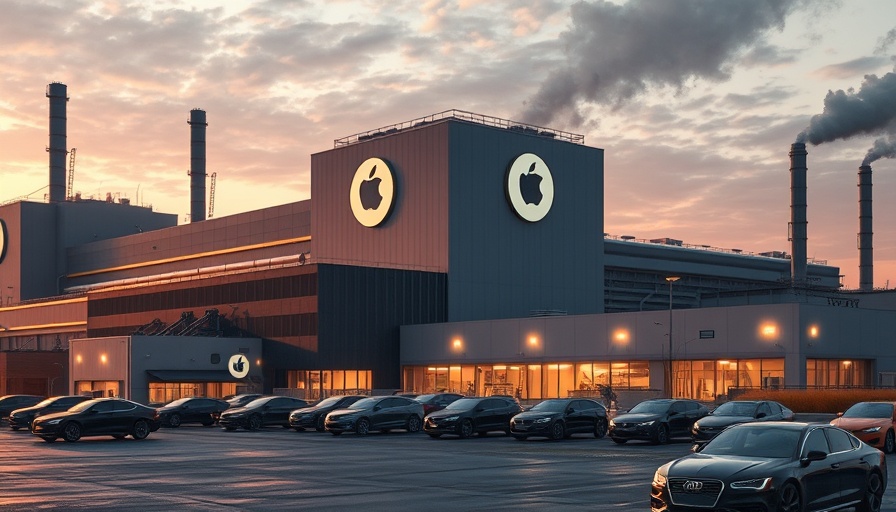
Understanding the Electric Vehicle Revolution: A Surge in Demand
The electric vehicle (EV) revolution is gaining momentum like never before, with a projected sales figure exceeding 20 million units globally in 2025—an impressive 35% leap from Q1 2024. But while new vehicles fill showrooms, what's truly supporting this electrifying shift is the crucial infrastructure behind it: EV chargers. Particularly in the UK and US, the landscape of EV charger sales is witnessing dramatic changes as both regions strive to meet the burgeoning demands of drivers.
UK Charge Ahead: Growth That Speeds Past Expectations
In the UK, the EV charger market is not just growing; it’s booming, propelled by ambitious net-zero goals, leading to over 1.4 million registered EVs on the roads. By May 2025, the UK boasted 80,998 public charging points spread across 39,773 locations, reflecting a robust infrastructure being rapidly developed. Notably, the launch of ultra-rapid chargers (150kW +) stands out, with 1,291 new installations in early 2025, marking a staggering 58% increase from 2024's total of 3,200.
These high-capacity chargers allow drivers to add around 200 miles of range in just 15-20 minutes, appealing even to the most impatient drivers. Increasingly popular smart home and workplace chargers like Zappi and Ohme Home Pro are designed for efficiency, allowing users to leverage renewable energy and off-peak charging to save on energy bills. As we look to the end of the year, the UK’s charger market is projected to flourish, with an estimated value of £2.5 billion and a compound annual growth rate (CAGR) of 25.5% thanks to favorable government incentives and evolving regulations requiring fast chargers every 60 km along major routes.
US Charger Climate: Ambition Meets Demand
Meanwhile, the US charger market, valued at approximately $6.61 billion for 2025, is also on a growth path, with a projected CAGR of 23.99% extending through 2030. As of November 2024, there are over 205,000 public charging ports and 74,500 locations across the nation, with a notable addition of 2,490 public charging stations reported in a single month. A remarkable 30% of these stations are DC fast chargers, propped up by the ambitious National Electric Vehicle Infrastructure (NEVI) program, which aims to establish 500,000 chargers by 2030.
California leads the charge, home to nearly a third of the public stations, while states like Ohio and Texas are catching up with new NEVI-funded fast chargers appearing along major highways. Interestingly, 85% of EV owners in the US primarily charge their vehicles at home—often with Level 2 chargers that take between 6 to 8 hours for a full charge. The demand for residential chargers has surged, aided by the sales of 1.4 million plug-in EVs recorded in 2024.
Challenges Ahead: Funding and Infrastructure Hurdles
However, both markets are experiencing their fair share of challenges. In the US, there was a temporary freeze on $5 billion in NEVI funding in early 2025, leading to legal challenges that could impede progress. Fast chargers are becoming more prevalent, yet they face issues related to grid capacity, which affects high-performance EVs like the powerful Dodge Charger Daytona Scat Pack. In both the US and UK, enthusiasts worry about range anxiety due to the inconsistent availability of public charging stations, particularly in less urban areas.
Want to Stay Ahead? Look for Emerging Trends
As these markets evolve, consumers and industry insiders alike should aim to stay informed about the critical trends shaping the automotive landscape. Understanding the differences in charging infrastructure development between the UK and the US provides valuable insights not only for potential EV owners but also for automotive technicians and dealerships looking to capitalize on this transitional phase.
The Future of EV Charging: Impacts on Automotive Techniques
With technology evolving at a breakneck pace, it’s essential to explore how these developments impact automotive engineering and service practices. Professionals within the automotive field, from technicians to industry analysts, must adapt skills to meet new repair techniques and customer service strategies tailored for EV technology. This transition may also forge new paths in automotive sales—they will need to arm themselves with insider knowledge to educate customers effectively about the complexities of electric vehicle maintenance and operation.
Conclusion: Making the Electric Shift
The rapid pace at which the UK and US markets are expanding showcases the potential of the electric vehicle revolution and emphasizes the need for robust charging infrastructure to support this transition. As new innovations come to the forefront of automotive technology, both consumers and industry professionals will benefit immensely from gaining insider tips on navigating the evolving landscape of EVs.
 Add Row
Add Row  Add
Add 




Write A Comment